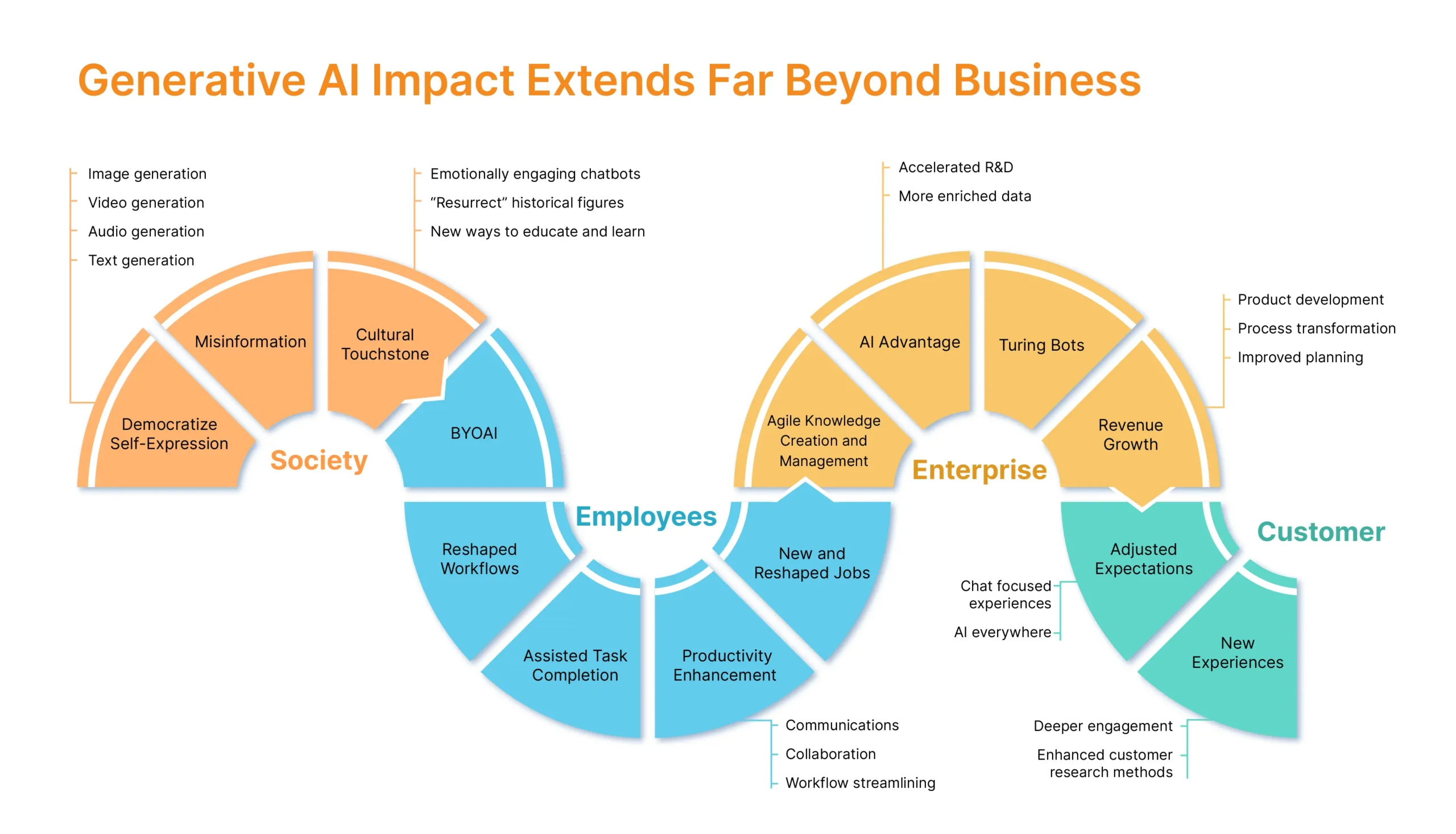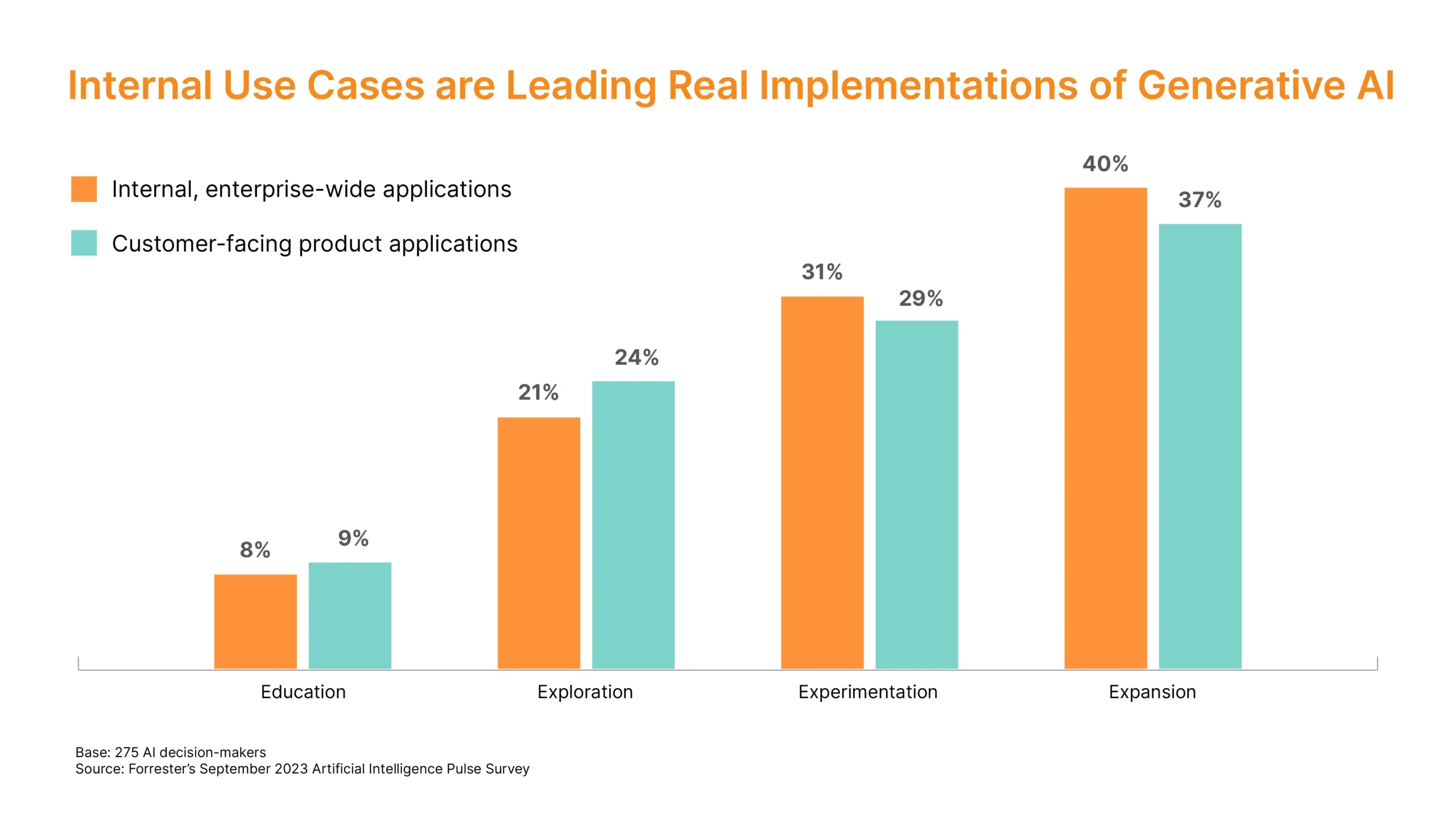“In this past year, we’ve only seen the first generation of these applications where everybody said, ‘Oh, we can use a large language model or diffusion model to execute tasks.’ And so we’ve had, a kind of an explosion of what I would call almost baseline capabilities, using it for knowledge, support, and more. And as everybody adopts this technology, we’re entering a world where essentially, everybody has a superpower. And so, in a world where everybody has a superpower, what does it mean to be a superhero?”
Excerpts from our recent webinar titled ‘Transforming Decision Intelligence: The Next Frontier with AI & GenAI’, a panel comprising experts across Forrester, Tiger Analytics, and Mars.
In a world where GenAI is becoming increasingly accessible, a new breed of superheroes is emerging – employees armed with the power of artificial intelligence. As we witness the first generation of GenAI applications, with large language models and diffusion models being harnessed for a myriad of tasks, we’re seeing an explosion of baseline capabilities in knowledge management, support, and various other domains. The adoption of these tools is becoming widespread, and we are entering a world where every employee possesses a superpower.

The democratization of AI has led to a significant shift in the way we work, offering unprecedented opportunities for growth and innovation. However, to truly unleash GenAI’s potential, organizations must focus on empowering their employees to wield these superpowers effectively. We’ve seen that the key lies in not fearing but embracing GenAI adoption among the workforce, ensuring that every individual is equipped with the knowledge, skills, and confidence to leverage these GenAI-powered tools.
But how do we transform our employees into AI superheroes? The answer lies in a comprehensive approach that addresses the challenges and concerns surrounding GenAI adoption while fostering a culture of continuous learning and growth. In our conversations with leaders and decision-makers, we’ve found that before harnessing GenAI capabilities to transform external processes, companies are increasingly focusing on developing AI projects aimed at enhancing internal productivity, from writing and communication support to coding and testing. Large Language Models are being used to organize data, summarize content, and transform information, making routine tasks more efficient.

As companies continue to invest in GenAI projects for internal productivity, it becomes crucial to ensure that employees are ready to embrace and leverage these powerful tools. By providing comprehensive training, fostering a culture of innovation, and showcasing real-world success stories, organizations can empower their employees to become the superheroes of the AI era, driving unprecedented levels of productivity and growth.
Empowering Employees with GenAI Adoption
In a broader context, one must understand that not all organizations are at the same level in their GenAI maturity. Experts believe it is wise to gauge employees’ awareness and comfort level in handling the GenAI productivity tool before rollouts.
Individual rollouts outweigh large rollouts
Limited launch, validating outcomes, and expanding users are the preferred formats for rolling out GenAI applications in enterprises. Large rollouts might help accelerate the timeline of AI evolution, but it is not easy to bring along the employees who are already overwhelmed with the AI zeitgeist. Assess each employee’s Gen AI readiness, skill gaps, and training requirements and build tailor-made, individualized, or function-specific rollouts to win employees’ confidence. A group of empowered employees would help in larger rollouts.
Research tools for every department
Our panel of experts have identified a trend of rethinking internal processes for better collaboration. Enterprise leaders are relooking at processes in every business function, including HR, finance, and supply chain. In such a climate, providing AI research tools for every department makes sense. This will ease the familiarization of large language models and understanding how GenAI positively impacts their functional operations. Tapping into the partner ecosystem for peer learning is a good way to amplify GenAI’s understanding and adoption.
Expert assistance through UI
In individual or small group-level rollouts, employees look for instant support and step-by-step guidance while experimenting with new tools. Traditional training aids may not be sufficient. Guided tutorials and support tools must be embedded into the user interface of GenAI applications. Also, there should be a provision for feedback loops so users can share feedback on how the application performs.
GenAI readiness assessment framework
Enterprises need custom frameworks to measure the AI readiness of individuals and teams. Everyone is not on the same plane. Industries like high-tech and retail banking are ahead in the GenAI adoption curve. When we look at the entire AI spectrum, there is a pool of technical talent: data scientists, machine learning engineers, data engineers, and BI developers. The hands-on exposure to GenAI for these talents varies greatly. Assessment frameworks should factor in the individualized AI maturity of these talents.
Use cases and changing tides
The most common GenAI use cases we’ve observed revolve around employee productivity and knowledge support. This essentially comes in two different flavors:
- Content generation: This involves enabling employees to enhance their productivity in writing, content creation, and similar tasks. This encompasses personalized marketing, content generation, and similar endeavors, both at an individual level and on a larger scale.
- Knowledge support: Facilitating access to information and accelerating knowledge acquisition processes.
Here’s an example. We’ve been working with fairly large pharmaceutical companies where they spend a lot of time going through research reports and reports about drugs, which could be leveraged across markets. So, for instance, if an employee wants to know more about what could be the implications if you were to launch in a European market – finding that information, and synthesizing it, was a manual research activity. With GenAI-powered systems, a lot of that information accessibility is becoming much more seamless for employees, leading to a productivity boost.
One of the biggest set of use cases that we saw throughout 2023, and we believe we’ll see even more, into 2024, is in the Customer Service and Support area. It’s using language models to further enhance the agents’ capabilities or the information collected from that customer interaction to drive better insights down the line. So we have folks in the telecom industry who are creating large language model-driven summarization of their call center transcripts, instead of having the agents write them from scratch. There will still be a final human-in-the-loop or a reviewer, but since the agents don’t have to write them from scratch, we’re saving time.
And then additionally, some of these agents are using the language models to extract some information from the transcripts themselves that will help drive downstream analytics. So when extracting some metadata, whether it be topics, entities, or things of that nature, the data has already been enriched as compared to more traditional types of text analytics.
Addressing the Challenges in GenAI Adoption
While looking at use cases and opportunities, we also need to pay attention to the new challenges that the adoption of GenAI tech presents. From building trust in AI outputs, addressing real concerns about job displacement, and navigating data privacy and security implications, these obstacles can be overcome with the right approach. By providing comprehensive training, showcasing real-world success stories, and establishing clear guidelines for responsible AI use, organizations can empower their employees to embrace GenAI with confidence.
As GenAI continues to evolve, the availability of diverse case studies demonstrating its positive impact on employee productivity and support will grow. Although most enterprise-led projects are currently in the experimentation and pilot stages, the potential for GenAI to enhance various business functions is immense. By highlighting the role of GenAI as a copilot that augments human capabilities and automates non-value tasks rather than replacing critical jobs, leaders can foster a positive narrative and alleviate employees’ concerns.
Moreover, the development of global standards and best practices for GenAI-related data privacy and security will provide a clearer framework for enterprises to navigate these complexities. As employees become more familiar with GenAI tools and understand how to handle the outputs of large language models responsibly, they will gain confidence in leveraging these technologies to drive innovation and efficiency in their work.
In the last year, enterprises have experienced a colossal surge of GenAI, impacting their operational capabilities. But having access to GenAI tools with their limitless potential is equivalent to holding the magic wand with superpowers. Democratization of AI means we are in a world where everybody has a superpower, including enterprise employees. Armed with the right skill set and supported by best practices, employees will gain the vantage point to exercise their GenAI superpower and build powerful enterprise applications. The first step in creating such a GenAI-empowered ecosystem is facilitating a conducive path and helping employees embrace this superpower.





